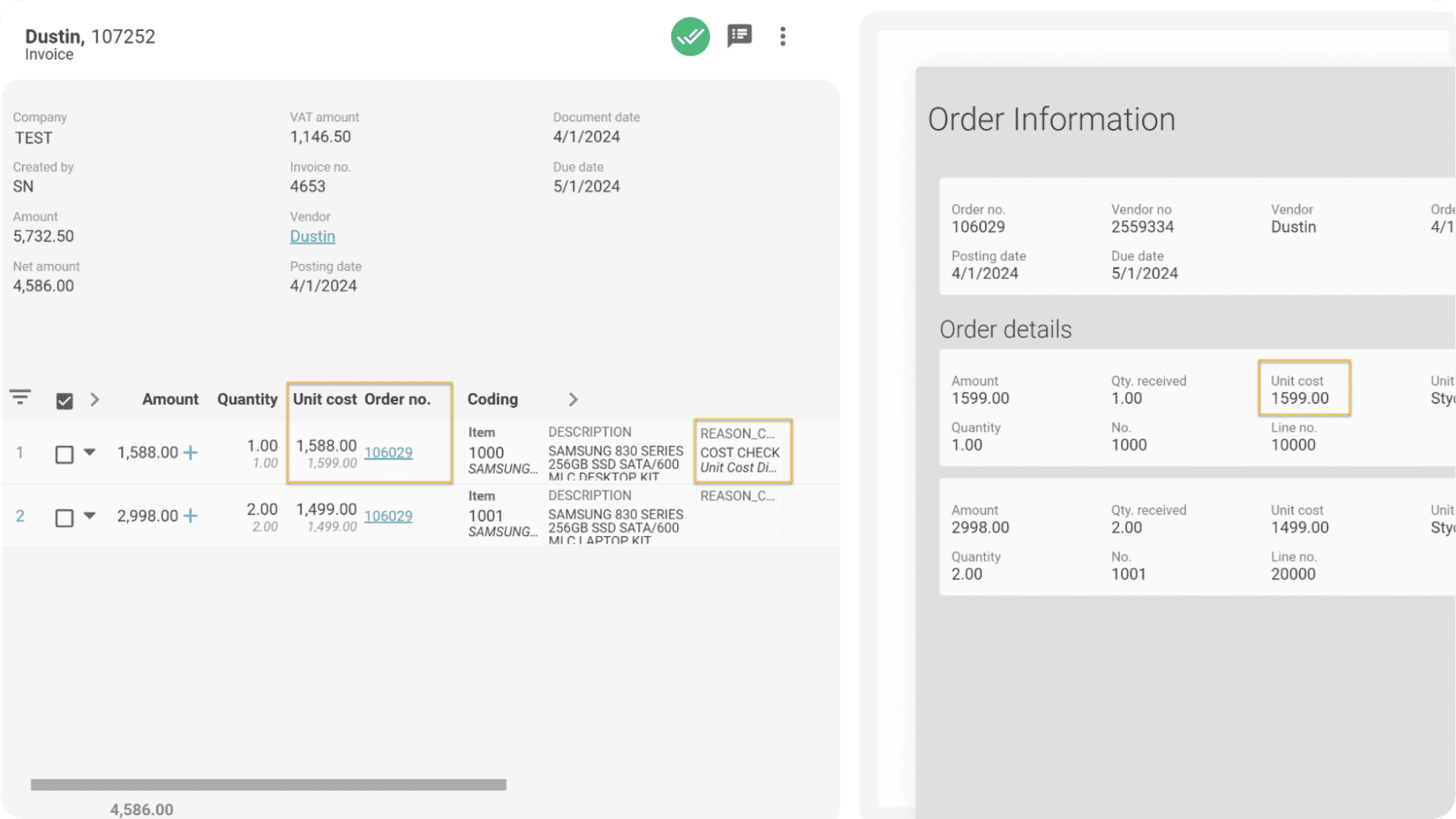Blog
3-Way Invoice Matching in Accounts Payable: A Guide
23 Jun
Blog
23 Jun

Three-way invoice matching is one of the most important controls in accounts payable. When it’s skipped or applied inconsistently, errors creep in, leading to duplicate payments, missed approvals, and supplier disputes. A structured process helps teams catch issues early and keeps payment cycles running smoothly.
This guide explains how 3-way invoice matching works, why it matters, and how to make it more efficient across your AP workflow.
Key highlights:
3-way invoice matching is a key control in accounts payable that verifies an invoice before payment. It compares three documents:
The process ensures that everything ordered, delivered, and billed lines up. When the details match, the invoice moves forward. If something’s off, it gets sent for review. This extra layer of verification helps prevent overpayments, catch errors early, and ensure only valid charges get approved.
Learn more about the different invoice matching types in D365.
When invoice matching is skipped or inconsistent, the downstream impact quickly increases. Without a reliable process in place:
The impact goes beyond the back office, too. According to an Institute of Financial Operations Leadership (IFOL) report, 41% of AP department leads prioritize stronger supplier relationships. That’s hard to do when vendors chase overdue or inaccurate payments caused by weak internal controls.
With a 3-way matching system, you prevent these breakdowns. It creates a consistent, auditable process for validating every invoice that supports trust, accountability, and smoother operations across teams and suppliers.
An accounts payable three-way match follows a straightforward six-step process, starting with a purchase order and ending with payment, but only when everything checks out:
Implementing 3-way invoice matching gives AP teams a structured way to catch mistakes before they become problems. It reduces risk, keeps records accurate, and brings more transparency to the invoice management lifecycle, all while supporting better supplier relationships.
The main benefits of a 3-way matching accounts payable process include:
Matching incoming invoices against purchase orders and delivery records helps stop overbilling before it reaches the payment stage. It flags duplicate charges, inflated pricing, and requests for never-received goods, all familiar sources of leakage.
It’s also a key defense against AP fraud. According to the Association for Financial Professionals, 24% of organizations that experienced fraud in 2024 faced invoice-related schemes.
Discover accounts payable fraud detection and prevention strategies for your enterprise.
Even minor invoice errors can create bigger problems. When accounts payable teams cross-reference line items across invoices, purchase orders, and receipts, it creates stronger protection against these issues. That extra diligence helps ensure suppliers get paid accurately and on time, keeping your financial records clean and reducing the risk of costly rework later.
According to the 2025 benchmark report from the Accounts Payable Association (APA), nearly 90% of organizations experience supplier disputes due to invoice errors. These disputes don’t just slow down payments — they chip away at trust. When vendors are left chasing answers, it creates unnecessary tension.
Stronger validation processes can reduce those gaps, improve communication, and support more reliable, long-term vendor partnerships. AP automation plays a key role in creating that consistency and clarity across every interaction.
Explore how AP automation strengthens supplier relationships.
Matching approvals to invoices and purchase orders doesn’t just keep payments in check, it also builds a reliable audit trail. That means showing who approved what, when, and under what conditions.
It’s not just about checking boxes. It’s also about responding quickly during compliance reviews and internal audits. A clear paper trail reduces risk, boosts confidence, and keeps your team prepared for whatever questions come their way.
When documents don’t line up, someone has to dig in and figure out what went wrong. That slows everything down, especially payments. Matching upfront minimizes errors, keeps invoices moving, and saves AP teams from chasing missing sign-offs or correcting the same issues twice. Fewer hiccups mean fewer holds and a smoother close.
Even with transparent 3-way match processes, AP teams can still hit roadblocks. These common issues slow down approval workflows or cause delays:
Manual matching leaves too much room for delays, mistakes, and missing information. With automation, your system checks invoices as soon as they arrive, so there’s no need to dig through inboxes or re-enter data. Eliminating that manual process gives AP teams more control and helps payments stay on schedule.
Manual, error-prone processes remain an obstacle for finance teams. According to a report by Ardent Partners, 20% of organizations say outdated workflows are one of their top challenges. By shifting to automation, AP teams improve accuracy, shorten payment cycles, and spend fewer resources on time-consuming rework.
By implementing automated 3-way invoice matching, organizations can:
Early payment discounts often go unclaimed, not because the money isn’t there, but because the processes take too long. When matching happens quickly and cleanly, invoices get approved faster, giving finance a real shot at capturing those savings. It’s a practical win: fewer delays and more room to make smart payment decisions.
Each department handles purchasing and approvals differently in many companies, making the invoice matching process messy. AI invoice automation helps bring order to that chaos by applying consistent rules across the board. Instead of chasing down missing invoice data or getting stuck with unclear approval handoffs, teams can rely on a shared process that keeps everyone in the loop.
Automated matching works best when it connects directly to your existing ERP or finance system. Instead of uploading files or copying data between platforms, information flows through one system. That reduces manual entry, helps catch mismatches early, and keeps records accurate without extra admin work.
Without automation, it’s hard to know where an invoice stands, or why it’s stuck. Automated accounting systems offer real-time tracking, so teams can see if something is pending, matched, or needs follow-up. That visibility helps maximize the ROI of your ERP, respond to supplier inquiries faster, and avoid surprise escalations.
Matching helps prevent errors, but it can slow teams down without structure. Defining clear rules and tightening how you handle documents helps AP stay efficient without losing control. Here are the five best practices for reducing unnecessary steps and making the process easier to manage:
High-value or complex orders should undergo complete matching, but AP can often approve smaller purchases with fewer checks. Setting clear dollar thresholds helps AP teams focus their time where it matters most without holding up low-risk invoices in the queue.
Minor mismatches, such as a small price difference or a slight quantity variation, don’t always need to hold up approvals. When AP teams define clear tolerances and communicate them up front, it’s easier to keep invoices flowing without flagging every slight discrepancy for manual review.

When POs, receipts, and invoices live in different places, matching takes longer, and errors slip through. Housing everything in one invoice management system, where approvals, attachments, and status updates are easy to find, gives AP the necessary visibility to work efficiently. It also makes audits and troubleshooting a lot less painful.
Some vendors consistently submit clean, accurate invoices, while others don’t. Tracking this over time allows AP to flag high-risk suppliers and adjust workflows accordingly. Case in point: Over 20% of leaders say poor invoice accuracy is a key obstacle to efficiency, according to APA’s 2025 benchmark report.
Delays often start because teams wait for all documents before doing anything. But getting a head start, and reviewing invoices as they come in, helps surface missing POs or receipts early. That way, issues can be raised and resolved in parallel, instead of holding up the process at the last minute.
ExFlow AP for Finance & Operations and Business Central helps simplify the 3-way invoice matching process directly within Dynamics 365 for high-volume finance teams. It embeds automation into your existing systems, reducing manual work, increasing visibility, and supporting compliance.
Key ExFlow features include:
Book a demo today, and see how ExFlow can help your finance team optimize invoice matching and boost efficiency.